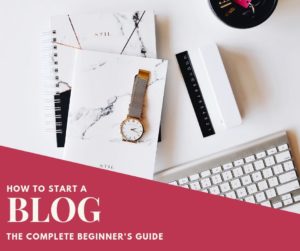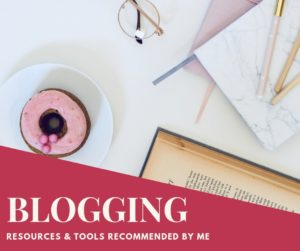How To Sell Your Low Ticket Offer to a Cold Audience Using Facebook Ads
I am an affiliate with links to an online retailer in this blog post. When you read what I have written about a particular product and click on that link and buy something from the retailer, I can earn a commission. Please note that I only recommend products that I truly believe in and use in my business. Please read my full disclaimer here
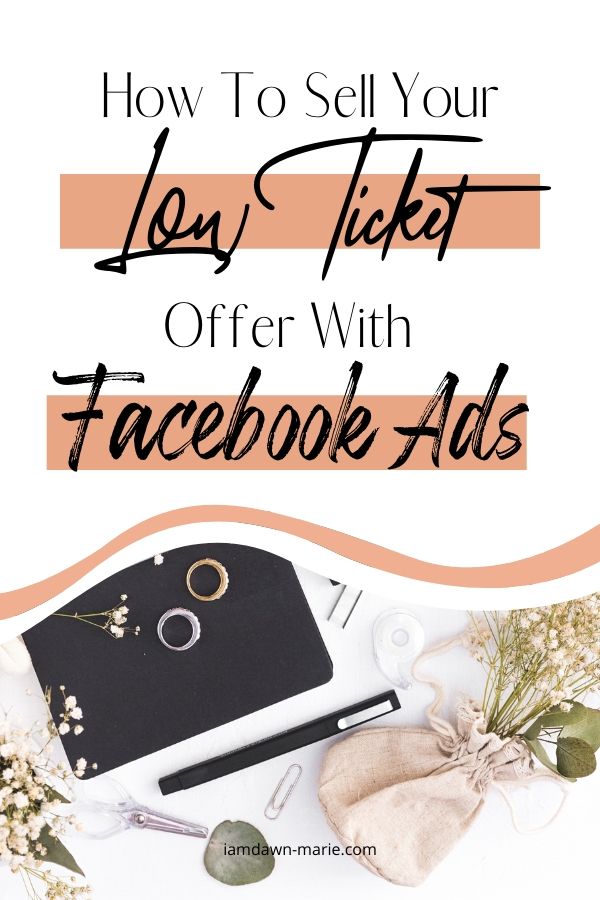
Now what I say in this article is probably everything that goes against what I typically preach and that is – to never sell to a cold audience.
But I would like to share with you a strategy that helps you sell your low ticket offers to cold audiences using Facebook Ads.
Squashing the jargon
Before I get started, I want to tackle some of the jargon that I will be using in this post, just in case you have never heard of the words.
What is low ticket? A low ticket offer is simply an offer that might cost no more than $100 or £100; whatever your currency is. I have seen some low ticket offers stand as eBooks, mini video courses or webinars. Whatever content you want to provide, it is expected that your offer will be under the $100 threshold.
What is a cold audience? A cold audience is a group of people who have never heard about you before. If they see your ads on Facebook for the first time, or they are seeing your name and brand for the first time, then they are considered cold.
What is Facebook Ads? This is the ability to put your offer in front of a wider group of people by paying money to be seen. As a business owner, you can create Facebook Ads directly from your Facebook Business Page. You may see this as a “boost post” or you can create an ad from the Facebook Ads Manager. In this article and any content I create, where I speak about Facebook Ads, I am talking about creating ads through your Ads Manager and NOT as a boosted post.
Why low-ticket offers are working right now
A lot of people right now are nervous about running Facebook Ads because they think that with the Corona virus pandemic and a lot of people being laid off, that no one is spending.
In fact this is further from the truth.
A lot of people are still looking for solutions to their problems and they would be willing to spend the right amount of money on a product that solves their problem. This is why low ticket offers, without the hefty price tag, are a great exchange.
Here’s what I’m seeing with Facebook Ads and low ticket offers right now:
- A brand new low ticket offer, selling at $37 with a few upsells that go up to $97 has just hit $20k in a month.
- New members coming into a membership for less than $15. The membership cost is $49 per month and most of the members stay for 6 months or more.
Can you package what you know into an eBook or 4-part video series and sell it?
Selling low-ticket offers right now is a great way to get new people to know about you, but not only that.
When people buy low-ticket offers, they’re saying they trust you enough to buy from you. Plus you’re building your email list for free and you’re building it with BUYERS – every email list builder’s dream.
Instead of building your email list with people who may not buy from you ever, you can start building your email list with people who are serious enough to take the first step with you.
And if they’re willing to take that first step with you, then it means that when you do come out with a higher-priced offer later on, once everything goes back to normal, they will be front and centre, ready to take out their credit card, because you’ve already built the trust with them.
Convinced? Ok let’s talk strategy.
Strategy to sell low-ticket offers using Facebook Ads
So I always go on about not selling to a cold audience.
In some niches however you can get away with selling to a cold audience. For example, eCommerce products do really well for impulse buyers on Facebook.
If however you’re a course or workshop creator, the typical rule is to build an email list and then nurture your email list with content so you can build a relationship with them.
This is still true, but this time, the strategy to selling to a cold audience is to build your funnel on Facebook itself.
What do I mean by this? If you think of your email sequence, you might have a 5-day or 10-day email sequence, providing valuable content to your subscribers telling them how good you are, how good your offer is and why they should buy.
Well instead of creating that content off of Facebook and through email, you can create that content and share it by creating an ad funnel using Facebook Ads.
Now typically advertisers will create an offer, set up a sales page, select their Facebook ad cold audience and drive traffic to the offer to see if it converts.
Whilst this method can work to bring you sales, what I have found when I implemented this myself, is that I would make sales but I would either experience a break even campaign or a loss. If I made any profits, it would be a small profit margin.
So what I have done instead is set up an ad funnel that included a brand awareness campaign, a nurturing campaign and then an offer campaign.
Here is how this might look.
Ad one will be the ad that starts off at the top of funnel to a cold audience.

In this campaign, you can either use the video view objective or you can use the conversion objective, if you’d also like to build your email list.
The aim here, will be to get as many video views of your video.
Make sure that your video is short and concise. A video that is no more than 5 minutes is a good time frame, since we also need to be conscious of the fact that people do not have time. You want to be able to capture people’s attention in as short a time as possible and help Facebook give you the data you need.
The data that we need here is video views.
Next you can create a retarget campaign. The audience that you ad to this campaign, will be those people who watched at least 50% of your first video.
Why 50%? Because it is expected that if people spent their time watching the majority of a video, means that they were fascinated by it and could potentially be interested in the topic.
The second ad will follow on from the first ad and would look something like this.
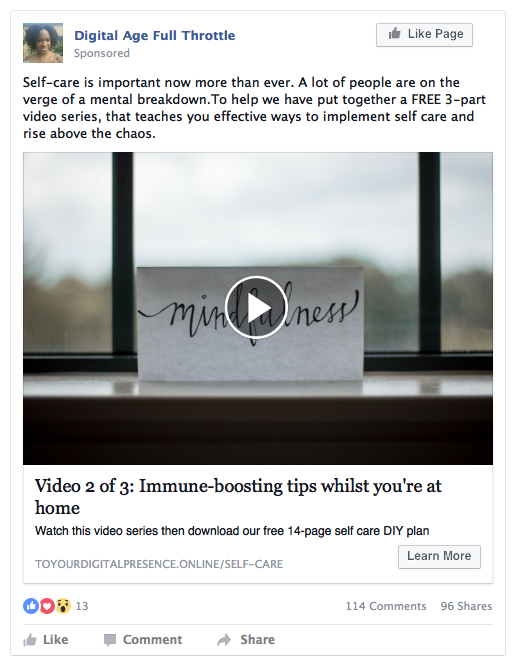
We then repeat the process for our third ad, which is to retarget people who watched 50% of video 2 and this time we will direct them to a third video to complete the video series.
That ad might look something like this.
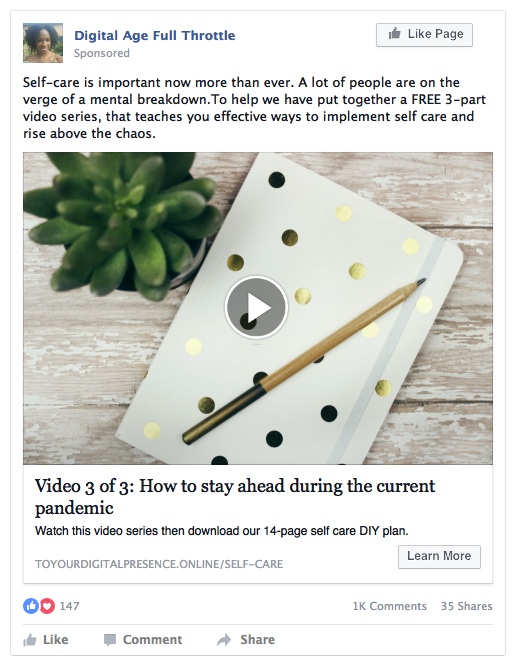
Now that your nurturing content has been delivered, you have delivered some free content to turn your cold audience into a warm audience you can start the selling process here.
Your next ad will be where you pitch your offer to those who actually completed the video series.
This time, you can send those people to your sales page to buy your offer, which should be very relevant to your free video content. Here’s what your last ad would look like.

Don’t forget to make sure that your sales page is pixelled, so that anyone who does not buy from you, can be retargeted at the bottom of the funnel where perhaps you show them testimonials from people who have purchased your product already or you can show them an ad that answers questions. This way you’re able to overcome any objections that they may have.
So it is possible to sell to a cold audience, but there is still an element of warming them up, if you want to have a better return on your ad spend.
This is a strategy that has worked for me because it’s important to keep in mind that although you can sell to a cold audience, you have to be smart about it, if you wish to get a return on your advertising dollars.
So here’s what you can do. You can either test a direct response ad, where you drive traffic directly to your sales page.
Or you can test the strategy above where you create an ad funnel to funnel people from the brand awareness stage to the selling stage.
If you have tried this strategy let me know what your results were like in the comments below.
If you’d love to try this strategy with your own low-ticket offer, I’d love to see how I can help. Let’s set up a free strategy call to discuss how this strategy and Facebook Ads can work for you. Click here to get started. Looking forward to it.
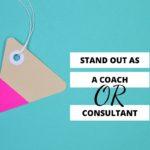 Previous Post
Previous Post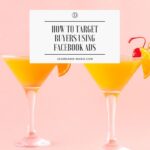 Next Post
Next Post
